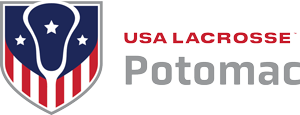About
Lacrosse
About The Sport
Lacrosse, considered to be America’s first sport, was born of the North American Indian, christened by the French, and adapted and raised by the Canadians. Modern lacrosse has been embraced by athletes and enthusiasts of the United States and the British Commonwealth for over a century.
The sport of lacrosse is a combination of basketball, soccer and hockey. Anyone can play lacrosse — the big or the small. The game requires and rewards coordination and agility, not brawn. Quickness and speed are two highly prized qualities in lacrosse.
An exhilarating sport, lacrosse is fast-paced and full of action. Long sprints up and down the field with abrupt starts and stops, precision passes and dodges are routine in men’s and women’s lacrosse. Lacrosse is played with a stick, the crosse, which must be mastered by the player to throw, catch and scoop the ball.

Lacrosse is one of the fastest growing team sports in the United States. Youth participation in the sport has grown over 77% since 2006 to nearly 400,000 in 2012. No sport has grown faster at the high school level over the last 10 years and there are now an estimated 282,000 high school players. Lacrosse is also the fastest-growing sport over the last nine years at the NCAA level with 671 college teams in 2012, and that’s just the tip of the iceberg. There are more than 500 college club programs, including nearly 200 women’s teams that compete at the US Lacrosse Intercollegiate Associates level.
A Brief History Of Lacrosse

With a history that spans centuries, lacrosse is the oldest sport in North America. Rooted in Native American religion, lacrosse was often played to resolve conflicts, heal the sick, and develop strong, virile men. To Native Americans, lacrosse is still referred to as “The Creator’s Game.”
Ironically, lacrosse also served as a preparation for war. Legend tells of as many as 1,000 players per side, from the same or different tribes, who took turns engaging in a violent contest. Contestants played on a field from one to 15 miles in length, and games sometimes lasted for days. Some tribes used a single pole, tree or rock for a goal, while other tribes had two goalposts through which the ball had to pass. Balls were made out of wood, deerskin, baked clay or stone.
The evolution of the Native American game into modern lacrosse began in 1636 when Jean de Brebeuf, a Jesuit missionary, documented a Huron contest in what is now southeast Ontario, Canada. At that time, some type of lacrosse was played by at least 48 Native American tribes scattered throughout what is now southern Canada and all parts of the United States. French pioneers began playing the game avidly in the 1800s. Canadian dentist W. George Beers standardized the game in 1867 with the adoption of set field dimensions, limits to the number of players per team and other basic rules.
New York University fielded the nation’s first college team in 1877, and Philips Academy, Andover (Massachusetts), Philips Exeter Academy (New Hampshire) and the Lawrenceville School (New Jersey) were the nation’s first high school teams in 1882. There are 400 college and 1,200 high school men’s lacrosse teams from coast to coast.
The first women’s lacrosse game was played in 1890 at the St. Leonard’s School in Scotland. Although an attempt was made to start women’s lacrosse at Sweet Briar College in Virginia in 1914, it was not until 1926 that Miss Rosabelle Sinclair established the first women’s lacrosse team in the United States at the Bryn Mawr School in Baltimore, Maryland.
Men’s and women’s lacrosse were played under virtually the same rules, with no protective equipment, until the mid-1930s. At that time, men’s lacrosse began evolving dramatically, while women’s lacrosse continued to remain true to the game’s original rules. Men’s and women’s lacrosse remain derivations of the same game today, but are played under different rules. Women’s rules limit stick contact, prohibit body contact and, therefore, require little protective equipment. Men’s lacrosse rules allow some degree of stick and body contact, although violence is neither condoned nor allowed.
Field lacrosse is sometimes perceived to be a violent and dangerous game, however, injury statistics prove otherwise. While serious injuries can and do occur in lacrosse, the game has evolved with an emphasis on safety, and the rate of injury is comparatively low. Ensuring the safety of participants is a major focus for US Lacrosse and its Sports Science and Safety Committee, which researches injury data in the sport and makes recommendations to make the game as safe as practicable.
Rules of the Game
The rules of the game are designed to do two things – promote fair play and keep players safe.
Men's Rules
USA Lacrosse is committed to constantly reviewing and updating the rules of the game to ensure that those goals are always satisfied. We write and publish a stand-alone youth rule book for ages 14U and below, and in collaboration with the National Federation of State High School Associations (NFHS), we work together on the rules for boys’ high school lacrosse.
Useful Links
Women's Rules
The rules of women’s lacrosse are designed with safety in mind and to ensure fair competition. USA Lacrosse, the National Federation of State High School Associations and the National Collegiate Athletic Association write the rules for the sport in the United States and the organizations often work together on rule development and player safety. .
Useful Links
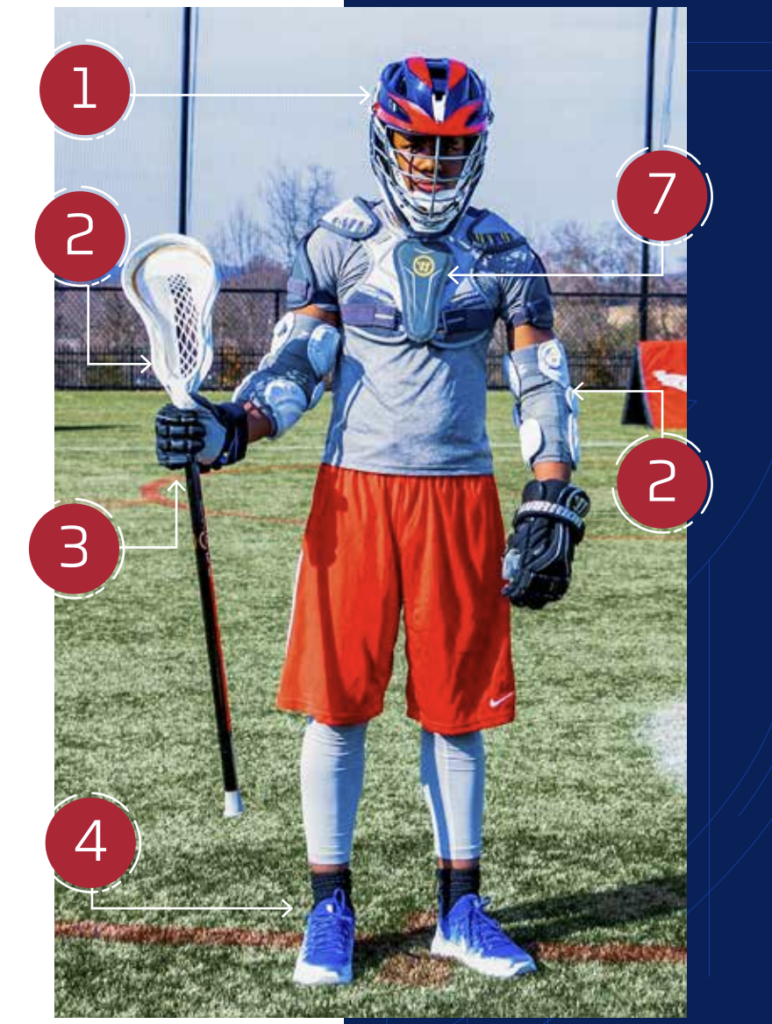
USA Lacrosse Equipment
Men's/Boy's Field Player Equipment
1. Helmet
Statement/seal indicating it meets NOCSAE lacrosse standard performance specification and SEI certified
2. FIELD PLAYERS CROSSE (Stick)
» Short Crosse – 40-42” » Long Crosse – 52-72”
» 10U and younger has allowances for shorter stick lengths (please reference the USA Lacrosse Boys’ Youth Rules Book).
3. Gloves
Hand must be fully inserted in glove
4. Shoes
Athletic cleats or athletic shoes
5. Protective Cup
Fitted for comfort & protection » Garments to improve comfort include: supporters, all-in-one briefs & combinations of both
6. Arm Pads
Elbow should be properly & completely covered
7. Shoulder Pads
Covers top of shoulder, collarbone & sternum » Should fit comfortably; adjust by loosening/tightening straps » NOTE: NOCSAE ND 200 compliant shoulder pads will be mandatory as of January 1, 2022
8. Mouthguard
Must be visible color other than clear or white » Self-molding (from manufacturers) or custom-molded (from dentist)
OPTIONAL: . RIB PADS (NOT SHOWN)
» Covers the ribs and kidneys; adjust by loosening/tightening straps » Should fit comfortably, not restricting breathing

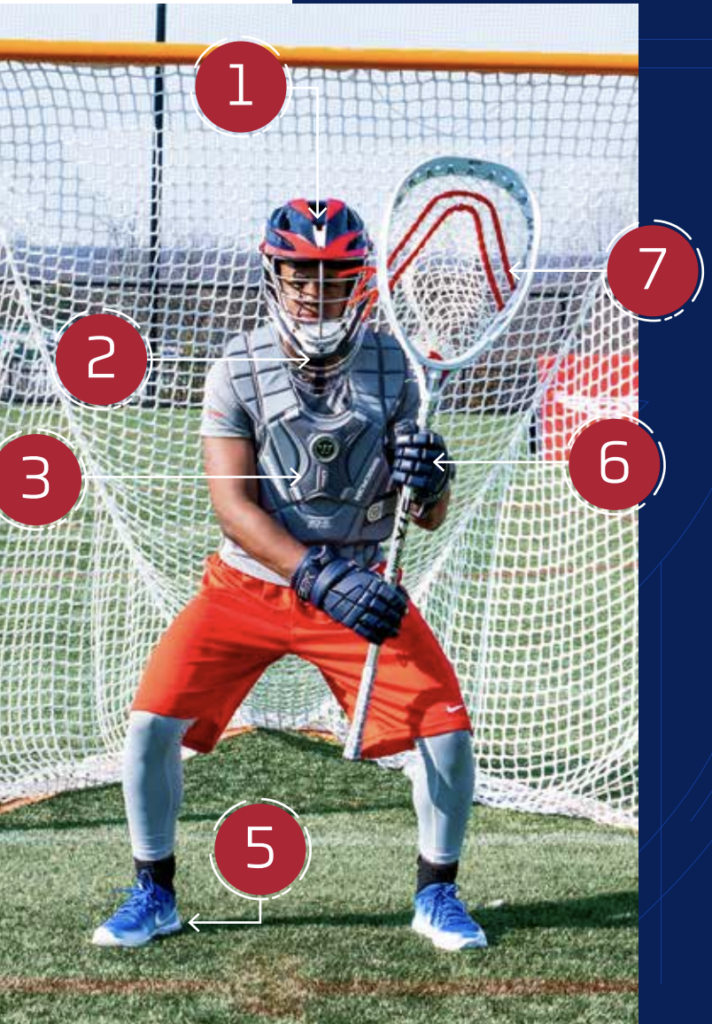
USA Lacrosse Equipment
Men's/Boy's Goalie Equipment
1. Helmet
» Statement/seal indicating it meets NOCSAE lacrosse standard performance specification and SEI certified
2. Throat Guard
Separate from helmet & required for goalies
» Attach with snaps/screws/other fasteners
» Proper fit for helmet & guard must be done relying on manufacturers’ guidelines & requirements on their website or included with helmet/guard
3. Chest Protector
» Covers front torso, neckline to below navel
» Body straps must be secured to the front of pad – adjust for a snug, comfortable fit
4. Protective Cup
Fitted for comfort & protection
» Garments to improve comfort include: supporters, all-in-one briefs & combinations of both
5. Shoes
Athletic cleats or athletic shoes
6. Goalie Glovers
Hand must be fully inserted in glove » Includes goalie specific additional thumb protection
7.Goalie Crosse
Length 40 – 72” » NOTE: 10U and younger has allowances for shorter stick lengths (please reference the USA Lacrosse Boys’ Youth Rules Book).
8. Mouthguard
Must be visible color other than clear or white » Self-molding (from manufacturers) or custom-molded (from dentist)

USA Lacrosse Equipment
Women's/Girl's Field Player's Equipment
1. Goggles
Meets the current ASTM standard for women’s lacrosse eyewear;
» SEI certified and bears the SEI mark.
» SEI Website seinet.org/search.htm#§ion=hidden-us_lacrosse
2. Crosse
Must adhere to Rule 2 Section 2 and meet the manufacturers specifications (Appendix B)
» Legal Sticks- usalacrosse.com/legal-womens-sticks
3. Mouthguard
Must be visible color other than clear or white
» Self-molding (from manufacturers) or custom-molded (from dentist)
4. OPTIONAL: Gloves
Must be close-fitting & should be comfortable for player while holding a stick.
5. OPTIONAL: Headgear
Meets current ASTM standard for women’s lacrosse headgear and has permanent SEI certification mark. » If it includes integrated eyewear, it must also meet that current ASTM standard.

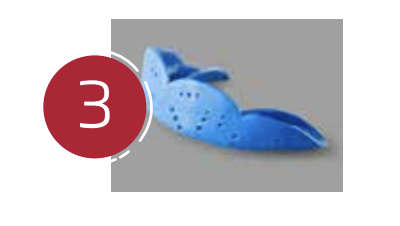
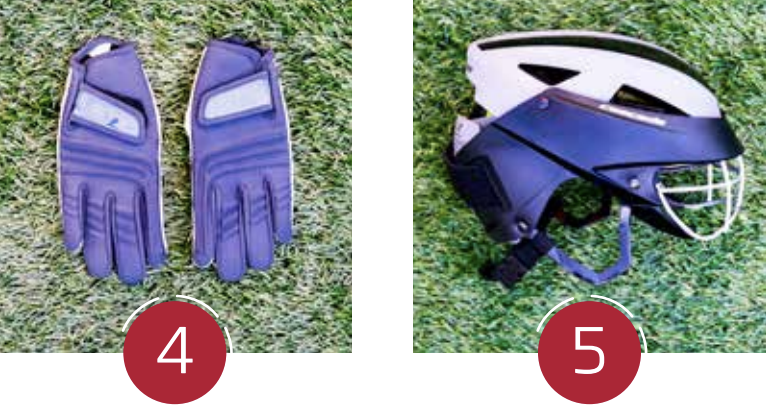
USA Lacrosse Equipment
Women's/Girl's Goalie's Equipment
1. Goggles
Meets the current ASTM standard for women’s lacrosse eyewear;
» SEI certified and bears the SEI mark.
» SEI Website seinet.org/search.htm#§ion=hidden-us_lacrosse
2. Throat Guard
Separate from helmet & required for goalies
» Attach with snaps/screws/other fasteners
» Proper fit for helmet & guard must be done relying on manufacturers’ guidelines & requirements on their website or included with helmet/guard
3.Chest Protector
Covers front torso, neckline to below navel
» Body straps must be secured to the front of pad – adjust for a snug, comfortable fit » SEI WEBSITE
4. Goalie Gloves
Hand must be fully inserted in glove » Includes goalie specific additional thumb protection.
5. Pelvic and Abdominal Protection
Generally incorporated as a part of thigh padding
6. Pelvic and Abdominal Protection
Generally incorporated as a part of thigh padding
7. Crosse
Must adhere to Rule 2 Section 3, Appendix B » Legal Stick List- usalacrosse.com/legal-womens-sticks
8. Mouthguard
Must be visible color other than clear or white
» Self-molding (from manufacturers) or custom-molded (from dentist)
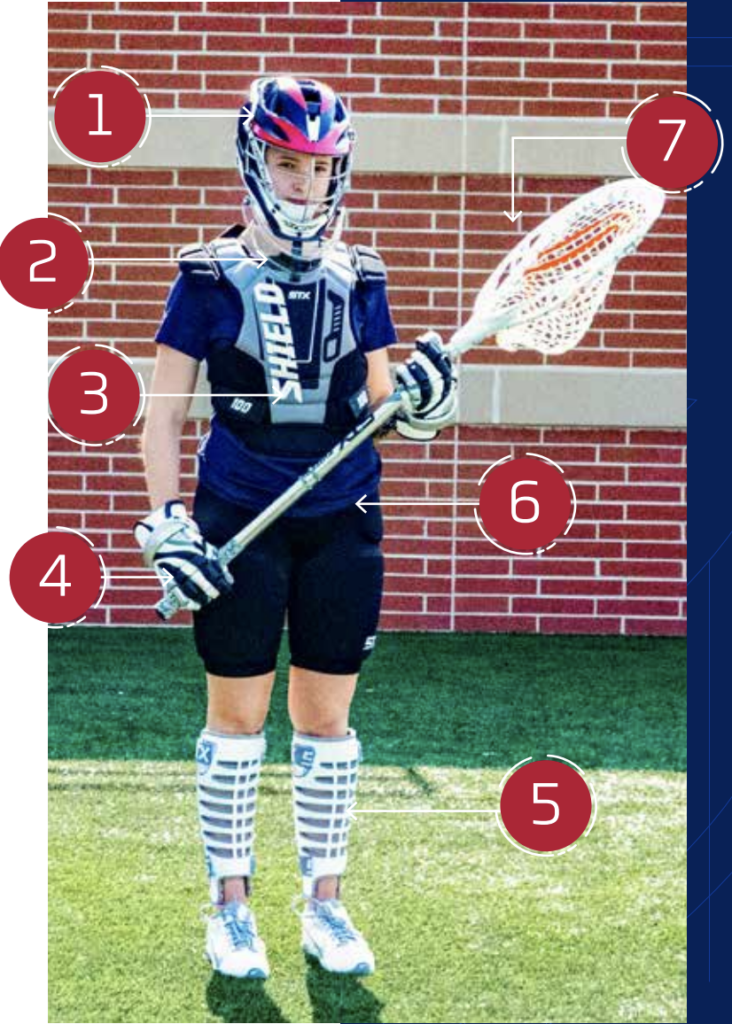

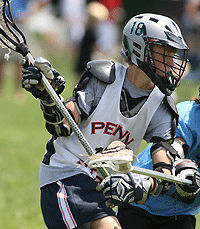
Participation Survey
The USA Lacrosse Participation Survey is produced annually to monitor participation at different levels of the sport across the country. This survey counts only participation on organized teams and does not include leisure-time play of lacrosse.
The primary source of data for this report are surveys completed by the active US Lacrosse regional chapters. Data is also obtained from US Lacrosse membership records, the National Collegiate Athletic Association, the National Federation of State High School Associations and www.laxpower.com.
